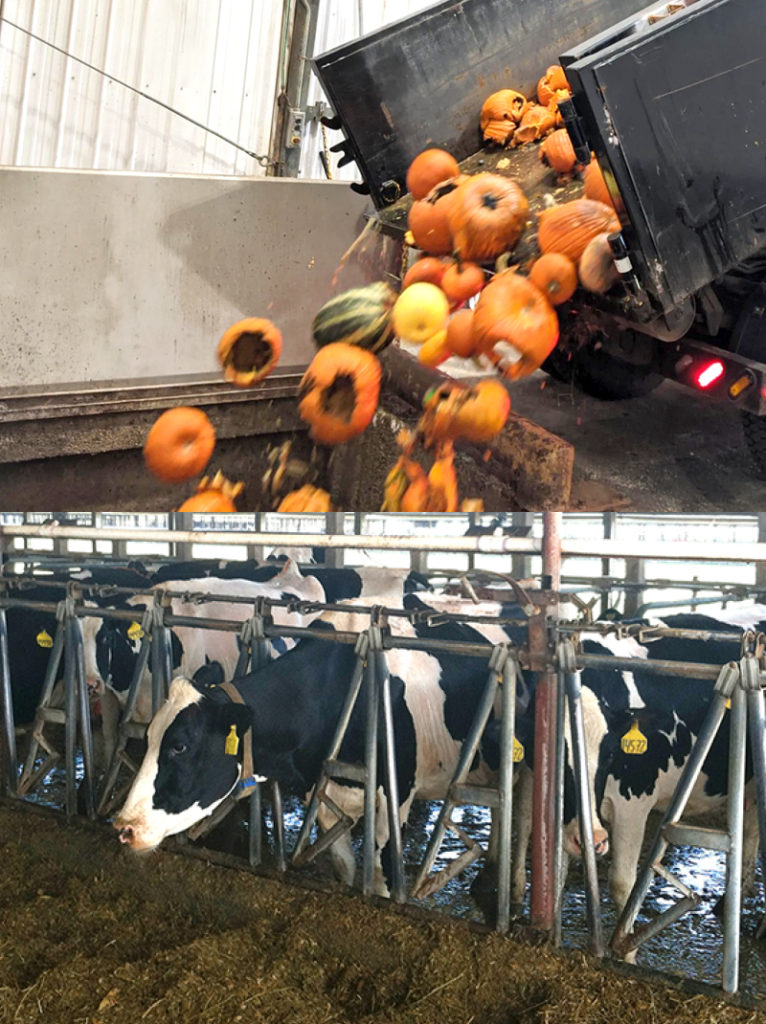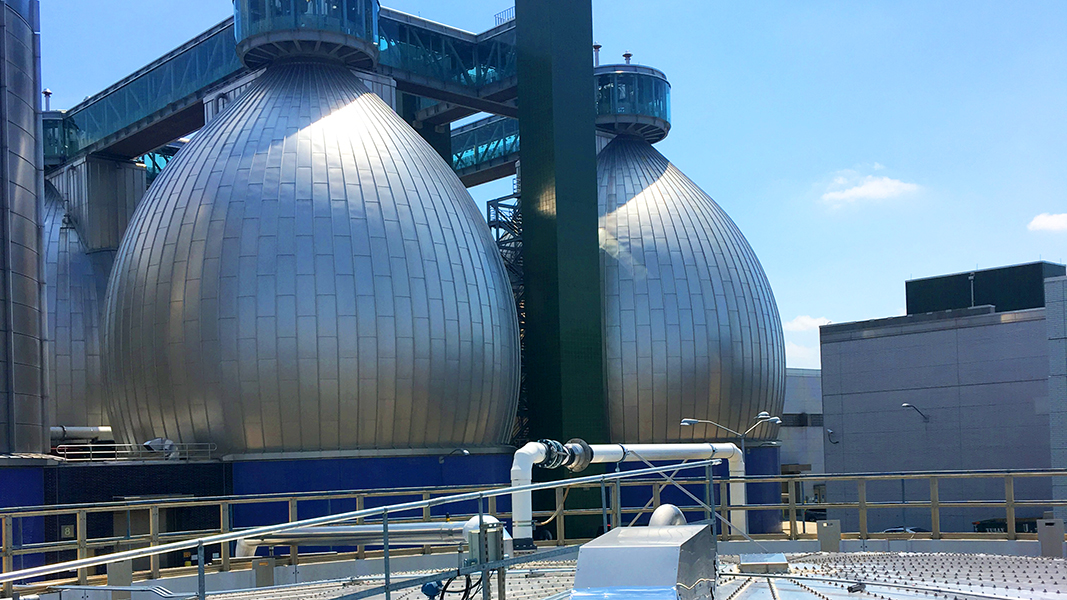Top: Newtown Creek (Brooklyn, New York) wastewater treatment plant anaerobic digesters.

Matt Tomich, President, and Joanna Underwood, Founder, of Energy Vision.
Matt Tomich and Joanna Underwood
As we prepare for a new year and new Administration that will prioritize safeguarding our environment and tackling climate change, we have a fresh chance to chart a green recovery, shift away from our fossil fuel economy, and ramp up renewables.
Some environmental advocates are looking to “electrify everything” to generate power and fuel our transportation systems, because electric motors are more efficient than combustion engines. But electrification is not a panacea. Take the transportation sector, for example, which emits the largest share of U.S. greenhouse gases or GHGs (28%). Electric batteries work well for passenger cars and other light duty vehicles, eliminating their tailpipe emissions, which can go a long way to decarbonization. But that’s not the whole story. Electric vehicles (EVs), in terms of their overall impact on the climate, environment, and public health, are only as clean as the energy sources charging their batteries, and the materials in them. If they are charged with solar, wind or other renewable sources, they would approach true zero emissions. But if their power comes from fossil fuel plants, the smokestack emissions from those plants are part of EVs’ overall “lifecycle” emissions.
In 2017, 62% of all U.S. power came from fossil fuels (30% from coal, 32% from fossil natural gas). Even California, which has a highly developed renewables market, got 56% of its power from fossil natural gas. Solar, wind, geothermal, and other power sources have gained more than 15% of the market, but are still many years away from ending our reliance on fossil fuel generation. Until they do, electric vehicles that plug into the grid will have lifecycle emissions that harm the climate.
Then there is the issue of how EVs’ lithium/cobalt/nickel batteries are produced. Cobalt is mined mostly in the poor, unstable Democratic Republic of the Congo, where it’s linked to child labor and deaths. Nickel mining and smelting generate high levels of toxic dust and air and water pollution. We can’t turn a blind eye to these challenges. Like all other energy technologies, batteries’ impacts need to be evaluated on a lifecycle basis, across their whole supply chain.
EVs also have documented performance problems. EV batteries lose 40% of their range in cold weather, according to an AAA study, and often don’t work well in heavy-duty transport applications, such as trains, buses and heavy trucks. Batteries lack the energy density heavy vehicles need, so they have serious reliability and range issues, struggling on hills and in heat or cold. The $1.2 million e-buses Albuquerque bought didn’t have the range needed to complete their routes, so the city returned them. The Minnesota Valley Transportation Authority experimented with an e-bus in the Twin Cities area and found its performance suffered badly whenever the temperature dipped below 20°F.
Despite drawbacks to heavy vehicle electrification, it’s barreling ahead. Sixteen states plus Washington, D.C. have pledged to make all their medium and heavy-duty trucks and buses “zero-emissions,” i.e., powered either by electricity or hydrogen fuel cells, by 2050. Fuel cells haven’t worked well in heavy vehicles yet either. Witness the troubles of Nikola, whose CEO resigned this fall amid accusations he tried to pass off a semi rolling downhill as running on hydrogen.
The Case For RNG
Heavy vehicles are only 4% of all U.S. vehicles, but consume 25% of all road fuel and emit 25% of GHGs in the transportation sector. They are a big component of overall emissions. If electrification and hydrogen fuel cells aren’t going to decarbonize heavy vehicle transport anytime soon, we need to deploy alternative technologies that can. One that is already succeeding is renewable natural gas (RNG), aka biomethane, an ultra-low-carbon fuel made from organic waste. More than 50,000 trucks and buses already run on it.

Seasonal pumpkins (top) unloading into receiving pit at the Quantum Biopower anaerobic digester in Connecticut. Dairy cows (above) at Fair Oaks Farm in Indiana, one of the pioneers in production of RNG. Photos courtesy of Energy Vision
Organic wastes are a costly environmental burden worldwide. They’re also a superb energy resource. RNG, made from waste, is a 100% renewable fuel, and the lowest carbon fuel available today — partly because RNG production captures the methane that rotting organic wastes would otherwise emit, and refines them into fuel. When food wastes and manures are the feedstocks, making RNG captures more GHGs (methane) than vehicles emit when burning it (carbon dioxide). So it’s not just zero-carbon, but net carbon-negative, over its lifecycle. That means RNG could potentially drive truck and bus GHG emissions below zero. Every truck and bus fleet converted to RNG would meet and exceed the Intergovernmental Panel on Climate Change’s 2050 emissions goals — not 30 years from now, but immediately.
RNG can also be key in decarbonizing other sectors, including the building sector, the sector of the U.S. economy that consumes the most fossil natural gas (54%) and emits 12% of GHGs (globally buildings emit 40%). New buildings can and should be powered by solar or other renewables, but there is a strong case to be made for switching the 48% of existing homes currently using fossil gas to RNG. It would require no up-front costs and confer many benefits. Not only can RNG slash GHG emissions compared to fossil gas, it also improves air quality, since it is nearly pure methane and burns much cleaner than fossil gas.
RNG can also help decarbonize the natural gas industry itself. Methane leakage from natural gas pipelines and biogas storage facilities is a very real problem, and the Biden administration will have to reinstate methane regulations and get the industry to tighten up on its GHG emissions. But RNG offers a complementary way to shrink the industry’s footprint. The more carbon-negative RNG carried in our natural gas pipelines, the more the climate impacts of existing natural gas infrastructure will be reduced.
As climate change continues to accelerate, effective climate action is urgent. We can’t afford to compromise effectiveness with one-size-fits all thinking or turf battles between competing decarbonization approaches. We need to quickly deploy different technologies where they make the most sense and can do the most good. The growing push to move away from combustion is a mostly positive development, but it makes no sense not to avail ourselves of a renewable, carbon-negative biofuel like RNG in the misguided zeal to “electrify everything.” It’s a catchy slogan, but we’d serve the climate better if the battle cry became, “electrify a lot.” The incoming Congress and Biden administration should take note: the optimal path to decarbonization will require a judicious mix of electrification, RNG, hydrogen, and other emerging solutions if we want to get to a truly sustainable future.
Matt Tomich and Joanna Underwood are the president and founder, respectively, of the nonprofit organization Energy Vision, whose mission is to research and promote viable technologies and strategies for a sustainable, low-carbon energy and transportation future.













